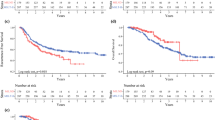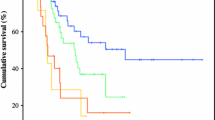Abstract
Background: The role of pelvic lymphadenectomy in melanoma metastatic to the superficial inguinal region remains controversial. Some researchers advocate aggressive surgical management,whereas others feel that outcome depends more on extent of disease rather than extent of treatment.We reviewed our recent experience to investigate possible therapeutic effects of extended surgery.
Methods: We performed a retrospective clinical and pathological review of 227 consecutive patients having superficial (SLND) or combined inguinal lymphadenectomy (CLND) for cutaneous melanoma.
Results: A total of 174 SLNDs and 53 CLNDs were performed. Overall 5-year survival for node-positive patients was 39%. Survival for patients with positive superficial nodes was 40%; for those with positive deep nodes it was 35% (P = ns). In node-positive patients, number and size of involved lymph nodes and the presence of extranodal spread, failure to receive adjuvant therapy, and tumor ulceration were associated with poorer prognosis. Extent of surgery was not associated with differential survival, although CLND patients had worse pathological features. Subgroup analysis showed no significant survival difference between SLND and CLND.
Conclusions: Some patients with deep nodal involvement apparently are cured by CLND. However, it is the biology of the disease and not the extent of surgery that primarily governs outcome. Patients with clinical or radiological evidence of pelvic nodal disease without evidence of systemic disease should have a CLND, but we find no evidence to support CLND if the pelvic nodes are clinically and radiologically negative.
Similar content being viewed by others
REFERENCES
Coit DG, Rogatko A, Brennan MF. Prognostic factors in patients with melanoma metastatic to axillary or inguinal lymph nodes. A multivariate analysis. Ann Surg 1991;214:627–636.
Balch CM, Soong SJ, Murad TM, Ingalls RN, Maddox WA. A multifactorial analysis of melanoma. III. Prognostic factors in melanoma patients with lymph node metastases. Ann Surg 1981;193:377–388.
Buzaid AC, Ross MI, Balch CM, et al. Critical analysis of the current American Joint Committee on Cancer Staging system for cutaneous melanoma and proposal of a new staging system. J Clin Oncol 1997;15:1039–1051.
Balch CM, Soong SJ, Bartolucci AA, et al. Efficacy of an elective regional lymph node dissection of 1 to 4 mm thick melanomas for patients 60 years of age and younger. Ann Surg 1996;224:255–266.
Sim FH, Taylor WF, Ivins JC, Pritchard DJ, Soule EH. A prospec-tive randomized study of the efficacy of routine elective lymphadenectomy in management of malignant melanoma. Cancer 1978;41:948–956.
Veronesi U, Adamus J, Bandiera D, et al. Inefficacy of immediate node dissection in StageI melanoma of the limbs. N Engl J Med 1977;297:627–630.
Morton DL, Wen D, Wong JH, et al. Technical details of intraoperative lymphatic mapping for early stage melanoma. Arch Surg 1992;127:392–399.
Thompson JF, McCarthy WH, Bosch CJM, et al. Sentinel lymph node status as an indicator of the presence of metastatic melanoma in regional lymph nodes. Melanoma Research 1995;5:255–260.
Albertini JJ, Cruse CW, Rapaport D, et al. Intraoperative radiolymphoscintigraphy improves sentinel node identification for patients with melanoma. Ann Surg 1996;223:217–224.
Reintgen D, Balch CM, Kirkwood JM, Ross MI. Recent advances in the care of the patient with malignant melanoma. Ann Surg 1997;225:1–14.
James JH. Lymphoedema following ilio-inguinal lymph node dissection. Scand J Plast Reconstr Surg 1982;16:167–171.
Urist MM, Maddox WA, Kennedy JE, Balch CM. Patient risk factors and surgical morbidity after regional lymphadenectomy in 204 melanoma patients. Cancer 1983;51:2152–2156.
Bowsher WG, Taylor BA, Hughes LE. Morbidity, mortality, and local recurrence following regional node dissection for melanoma. Br J Surg 1986;73:906–908.
Fortner JG, Booher RJ, Pack GT. Results of groin dissection for malignant melanoma in 220 patients. Surgery 1964;55:485–494.
McCarthy JG, Haagensen CD, Herter FP. The role of groin dissection in the management of melanoma of the lower extremity. Ann Surg 1974;179:156–159.
Haagensen CD. Surgical management of melanomas of the trunk and extremities. In: Najarian J, Delaney J, eds. Advances in Cancer Surgery. New York: Stratton Intercontinental Medical Book Co.,1976:285–306.
Finck SJ, Giuliano AE, Mann BD, Morton DL. Results of ilioinguinal dissection for Stage II melanoma. Ann Surg1982;196:180–186.
Dasmahapatra KS, Karakousis CP. Therapeutic groin dissection in malignant melanoma. Surg Gynecol Obstet 1983;156:21–24.
Karakousis CP, Driscoll DL. Positive deep nodes in the groin and survival in malignant melanoma. Am J Surg 1996;171:421–422.
Kissin MW, Simpson DA, Easton D, White H, Westbury G. Prognostic factors related to survival and groin recurrence following therapeutic lymph node dissection for lower limb malignant melanoma. Br J Surg 1987;74:1023–1026.
Coit DG, Brennan MF. Extent of lymph node dissection in melanoma of the trunk or lower extremity. Arch Surg 1989;124:162–166.
Singletary SE, Shallenberger R, Guinee VF. Surgical management of groin nodal metastases from primary melanoma of the lower extremity. Surg Gynecol Obstet 1992;174:195–200.
Fleming ID. Malignant Melanoma of the Skin. In Fleming ID, Casper JS,Henson DE, et al., eds. AJCC Cancer Staging Manual. Philadelphia, Lippincott-Raven, 1998;163–170.
Livingston PO, Wong GY, Adluri S, et al. Improved survival in Stage III melanoma patients with GM2 antibodies: a randomized trial of adjuvant vaccination with GM2 ganglioside. J Clin Oncol 1994;12:1036–1044.
Kaplan E, Meier P. Nonparametric estimation from incomplete observation. J Am Stat Assoc 1972;53:457–481.
Mantel N. Evaluation of survival data and two new rank order statistics arising in its consideration. Cancer Chemother Rep 1966; 50:163–170.
Cox D. Regression models and life tables. J R Stat Soc Br 1972; 34:187–220.
Gadd MA, Coit DG. Recurrence patterns and outcome in 1019 patients undergoing axillary or inguinal lymphadenectomy for melanoma. Arch Surg 1992;127:1412–1416.
Buzaid AC, Tinoco LA, Jendiroba D, et al. Prognostic value of size of lymph node metastases in patients with cutaneous melanoma. J Clin Oncol1995;13:2361–2368.
Karakousis CP, Emrich LJ, Rao U. Groin dissection in malignant melanoma. Am J Surg 1986;152:491–495.
Byron RL, Lamb EJ, Yonemoto RH, Kase S. Radical inguinal nodal dissection in the treatment of cancer. Surg Gynecol Obstet 1962;114:401–408.
Holmes EC, Moseley HS, Morton DL, Clark W, Robinson D, Urist MM. A rational approach to the surgical management of melanoma. Ann Surg 1977;186:481–490.
Kirkwood JM, Strawderman MH, Ernstoff MS, Smith TJ, Borden EC, Blum RH. Interferon alfa-2b adjuvant therapy of high-risk resected cutaneous melanoma: The Eastern Cooperative Oncology Group Trial EST 1684. J Clin Oncol 1996;14:7–17.
Gershenwald JE, Colome MI, Lee JE, et al. Patterns of recurrence following a negative sentinel lymph node biopsy in 243 patients with Stage I or II melanoma. J Clin Oncol 1998;16:2253–2260.
Author information
Authors and Affiliations
Rights and permissions
About this article
Cite this article
Mann, G.B., Coit, D.G. Does the Extent of Operation Influence the Prognosis in Patients With Melanoma Metastatic to Inguinal Nodes?. Ann Surg Oncol 6, 263–271 (1999). https://doi.org/10.1007/s10434-999-0263-5
Received:
Accepted:
Issue Date:
DOI: https://doi.org/10.1007/s10434-999-0263-5




